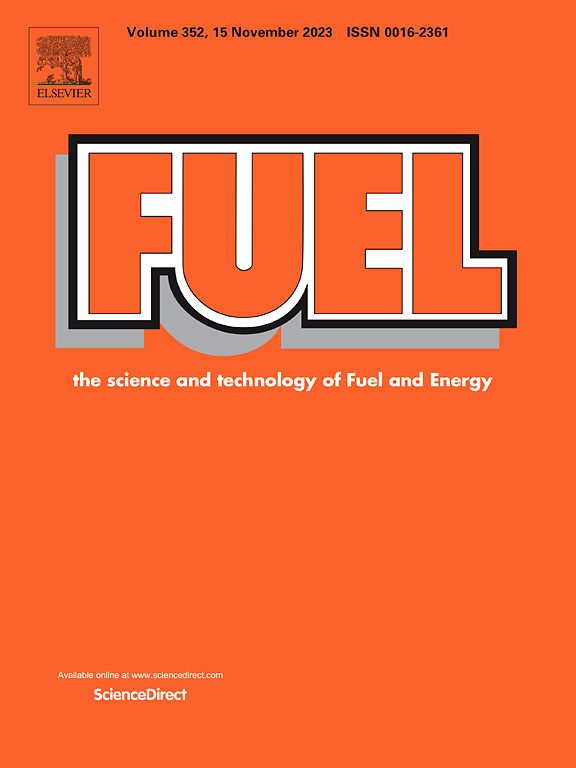富氢对预混丙烷旋流火焰火焰稳定性、热声振荡和燃烧特性影响的实验研究
IF 7.5
1区 工程技术
Q2 ENERGY & FUELS
引用次数: 0
摘要
本文介绍了富氢对C3H8/空气预混燃烧特性影响的实验研究结果和分析。为本实验研究开发的燃烧器的新颖之处在于它能够独立调节同心环空中的旋流和射流。这种设计可以在多种模式下运行:旋涡、射流、部分旋涡或分层,从而有效地模拟实际燃气轮机的条件。在这项工作中,燃烧器在完全预混的涡流条件下运行。系统地评估了氢富集(0 - 50%体积)和整体等效比(从井喷极限到1.0)。主要目的是量化氢添加对火焰稳定性、热声动力学、温度分布和排放性能的影响。实验结果表明,富氢显著提高了贫喷极限,最高可达21%。这种改进是由于增加了火焰速度、扩散率和OH自由基的产生。利用快速傅里叶变换(FFT)和相空间重构(PSR)的热声分析揭示了随着氢含量的增加,燃烧状态从稳定到不稳定的明显转变。这种不稳定性的特征是增强的压力-热释放耦合和极限环振荡。温度曲线对氢分数的敏感性有限,对当量比的依赖性较强。排放分析显示CO2(10.5%)和CO(33.3%)大幅减少。然而,这些好处伴随着氮氧化物排放量的适度增加(21%)。NOx的增加是由于火焰温度升高和自由基的形成。总的来说,这些发现突出了氢在提高火焰稳定性和燃烧效率方面的潜力。它们为建模和推进低排放、富氢燃烧技术提供了关键的实验基准。本文章由计算机程序翻译,如有差异,请以英文原文为准。
Effects of hydrogen enrichment on flame stability, thermoacoustic oscillations, and combustion characteristics in premixed propane swirl flames: An experimental study
This paper depicts the results and analysis of experimental investigations on the effect of hydrogen enrichment on the combustion characteristics of premixed C3H8/air flames in a Dual Annular Counter Rotating Swirl (DACRS) combustor. The novelty of the burner, developed for this experimental study, lies in its ability to independently regulate swirl and jet flows in concentric annuli. This design enables operation in multiple modes: swirl, jet, partially swirling, or stratified, thus effectively mimicking practical gas turbine conditions. In this work, the burner was operated under fully premixed swirl conditions. Hydrogen enrichment (0–50 % by volume) and global equivalence ratios (from blowout limits up to 1.0) were systematically evaluated. The primary objectives were to quantify the effects of hydrogen addition on flame stability, thermoacoustic dynamics, temperature distributions, and emissions performance. Experimental results demonstrated that hydrogen enrichment significantly extends lean blowout limits up to 21 %. This improvement is attributed to increased flame speed, diffusivity, and OH radical production. Thermoacoustic analysis, utilizing Fast Fourier Transform (FFT) and Phase Space Reconstruction (PSR), revealed a clear transition from stable to unstable combustion regimes with increasing hydrogen content. This instability was characterized by enhanced pressure-heat release coupling and limit-cycle oscillations. Temperature profiles exhibited limited sensitivity to hydrogen fraction, showing stronger dependence on equivalence ratio. Emission analysis revealed substantial reductions in CO2 (10.5 %) and CO (33.3 %). However, these benefits were accompanied by a moderate increase (21 %) in NOx emissions. This increase in NOx is attributed to elevated flame temperatures and radical formation. Overall, these findings highlight hydrogen’s potential to improve flame stability and combustion efficiency. They provide critical experimental benchmarks for modeling and advancing low-emission, hydrogen-enriched combustion technologies.
求助全文
通过发布文献求助,成功后即可免费获取论文全文。
去求助
来源期刊

Fuel
工程技术-工程:化工
CiteScore
12.80
自引率
20.30%
发文量
3506
审稿时长
64 days
期刊介绍:
The exploration of energy sources remains a critical matter of study. For the past nine decades, fuel has consistently held the forefront in primary research efforts within the field of energy science. This area of investigation encompasses a wide range of subjects, with a particular emphasis on emerging concerns like environmental factors and pollution.
 求助内容:
求助内容: 应助结果提醒方式:
应助结果提醒方式:


